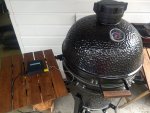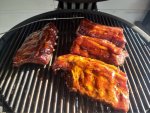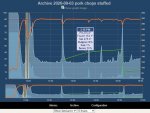Michel,
Nice looking graph. What kind of grill are you using.
Thanks! I'm using a Bastard Large, a dutch brand kamado.

A Couple of things here to add. The control is slow, so biggest mistake I see out there is trying to tune the control to be fast. Your current setup looks good. I use a Primo Jr grill which is on the smaller end of the ceramic grills out there. Over a few years I have learned the following:
1) Leave the default lid setting where they are. They work good and overshoot does not happen. You always want to come back to temp slow and steady
True. However, the default settings were for fahrenheit instead of celcius. So some adjusting was mandatory. ;-)
2) Make sure you do not have pit probe too close to flame. My probe hangs down from top center of dome and is close to where the mechanical probe is in the dome.
The pit probe is at grill level and I use a heat deflector.
3) NO LEAKS. Fix gaskets and make sure there are no leaks
My Bastard is equipped with fiberglass gasket. Haven't discovered any leaks so far (except for a very small one where the pit probe goes through. I know, I can run in through the top vent. However, I noticed hardly any difference in leakage.
4) Use the highest quality temp probes you can. Maverick probes do not fit well in probe jacks, so I do not use them because of that.
Agreed. I had a set of GrillEye Pro probes lying around, which seem to do pretty fine. However, I didn't use them this time because I'm doing ribs right now. So a 6-hour slow burn is fine for now ;-)
The pit probe is a low-budget thermocouple.
5) Make sure the damper can move easily. Do not tighten screw so much that the damper cannot move easily.
It runs as smooth as a baby bottom! ;-)
6) Over time I have got my config setting so the fan is used when I need a little temp or heating up, but the damper pretty much does the work after that.
I think the last adjustment Bryan suggested fixed that for me. The fan is pretty much idle right now. The damper seems to do all the work, which I think is good!
7) Last is to use the exhaust damper of the grill to fine tune. As temp raises, I open my damper a little more to keep the control steady. My damper is usually only open 2.5-6mm, depending on set temp.
The top vent is almost closed. Whenever there is hardly any airflow the temperature starts to drop, which I think is a good thing (If i read all the threads correctly). That's when the HeaterMeter kicks in.
adding my current config and last cook. Opened lid a few times to turn corn.
Thanks! Almost done with this 6-hour run. Time to eat!! ;-)









